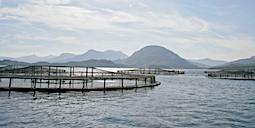The Scottish Salmon Company said its 2016 revenue was £110 million, up from £100.4 million in 2015, as strong market prices boosted the firm despite the salmon industry’s ongoing problem with sea lice.
Earnings before taxes in 2016 were £9.1 million compared to a loss of £405,00 in 2015.
The firm said the industry-wide “biological challenges and mortalities” reported in its previous quarter continued to have an impact on expected harvest volumes and drove up its production and operating costs by 15%.
Revenues for the fourth quarter were £27.2 million, up from £23.9 million in the fourth quarter of 2015, on harvested volumes down to 5,733 tonnes from 6,059 tonnes.
“Export sales accounted for 44% of output, an increase of 7%, as The Scottish Salmon Company continues to target overseas markets, leveraging the value of its provenance and the continued consumer demand for quality Scottish produce,” said the firm.
“Along with its Label Rouge line, its Native Hebridean Salmon is a key driver of export growth.
“Developed through an innovative brood stock programme, it offers 100% traceable Hebridean heritage.”
Fourth quarter harvested volume was 5,733 tonnes, down from 6,059 tonnes in the same quarter in 2015.
Full-year 2016 harvest volume was 24,300 tonnes, and the firm expects 25,000 tonnes in 2017.
The Scottish Salmon Company CEO Craig Anderson said: “Biological issues continued to affect the forecasted rise in volume, however, we have made good progress in treating these issues, the global salmon market is strong and prices are forecast to remain high.
“We experienced a notable increase in sales over the festive period, demonstrating the continuing demand at home and overseas for Scottish salmon as a premium food product.
“New site development is an integral part of our growth strategy and continues to be a key focus.”
Trials on the firm’s new harvest station in Ardyne, Argyll, were completed during the fourth quarter and the facility became fully operational in January along with the company’s new well boat.
The firm said both of these investments will allow greater capacity and flexibility when harvesting and improve speed to market.
In addition, a number of smaller farms in the north region were consolidated into a single 3,400 tonne operating site, improving efficiencies and economies of scale.
